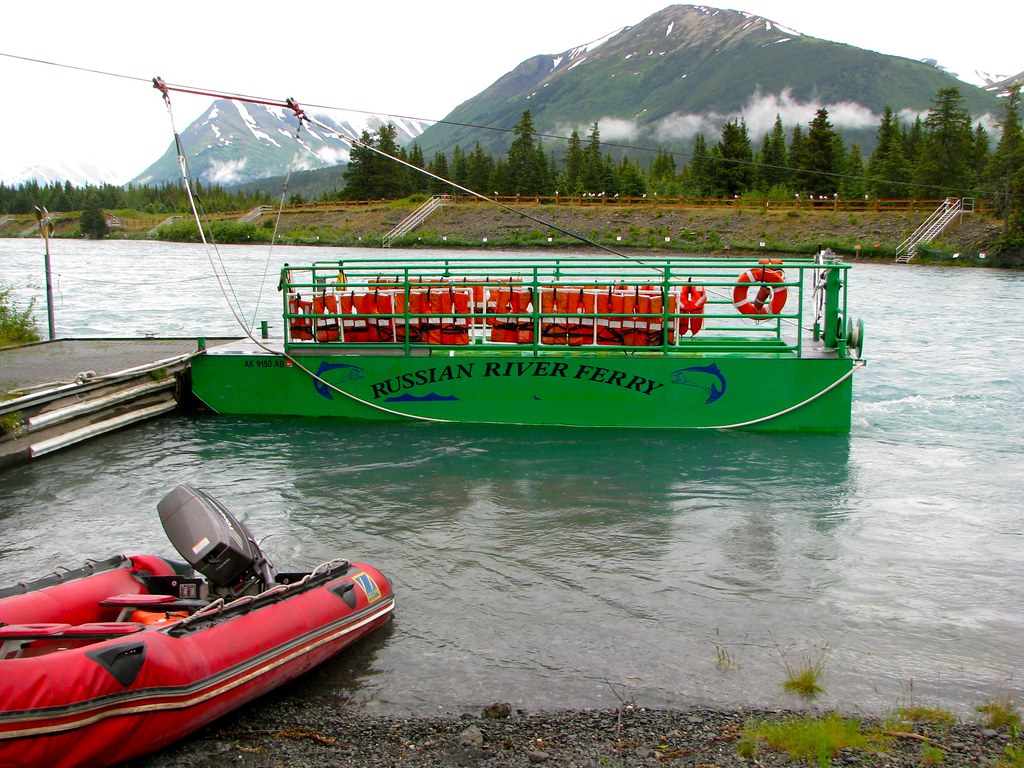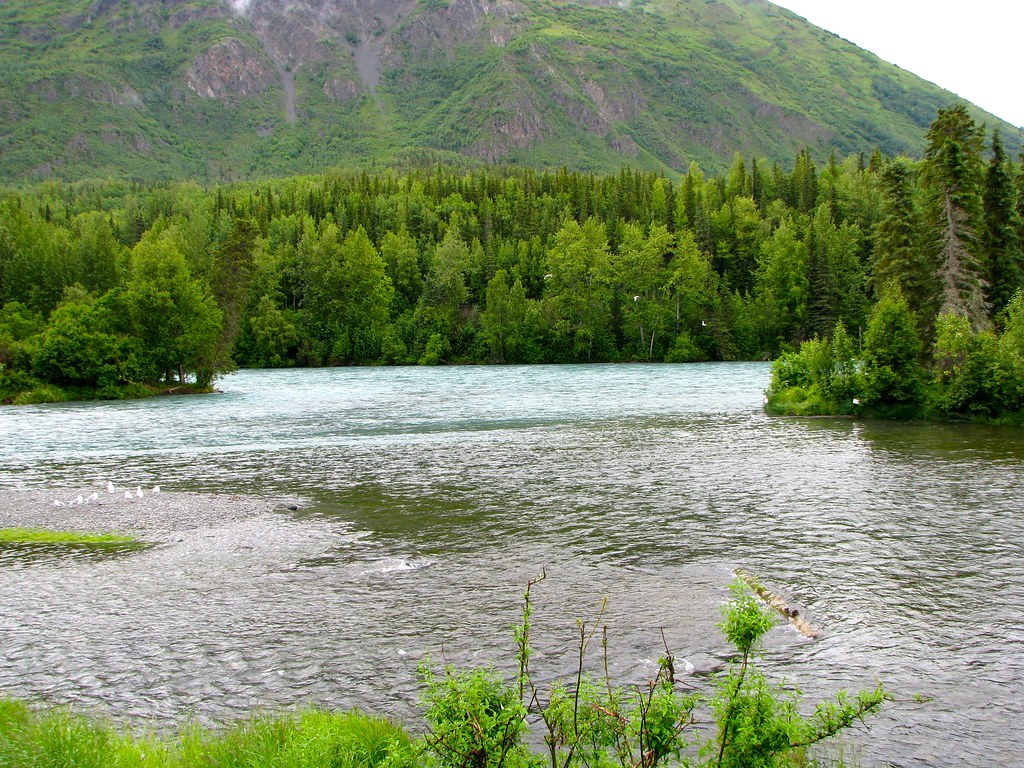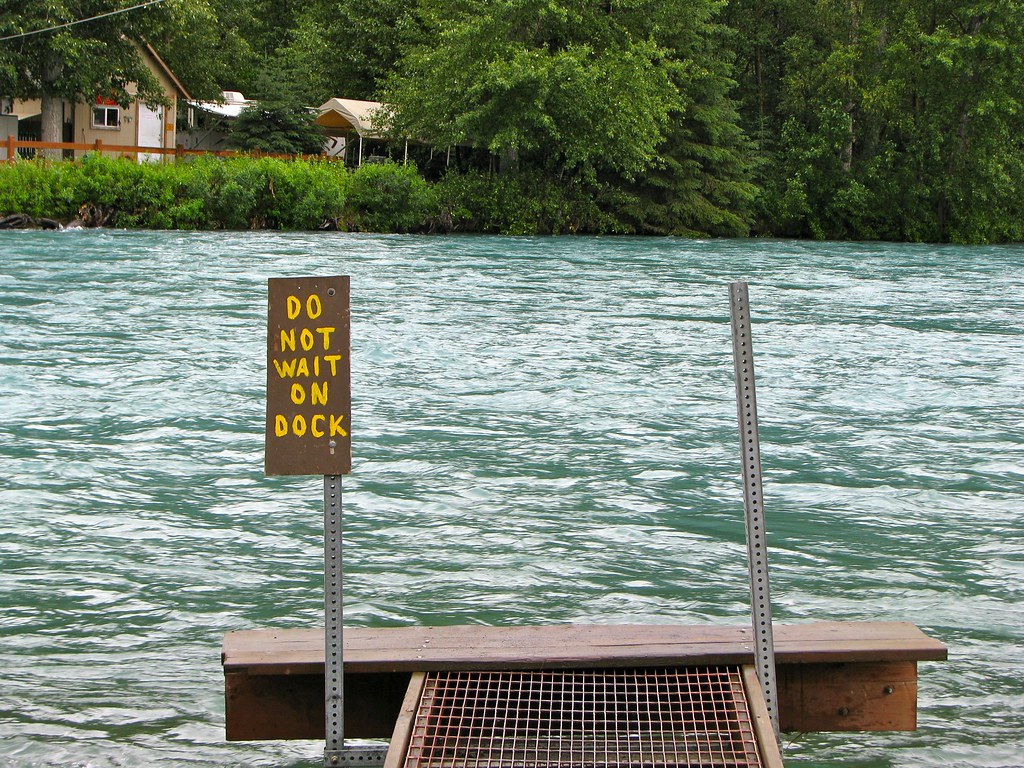Chugach National Forest, Cooper Landing, Alaska (July 2010)
The Russian River Ferry is certainly one of the more unusual ferries that I’ve experienced (and I’ve taken rides on many others). It doesn’t function to link communities on opposite riverbanks or to unite a ribbon of asphalt or to provide a shortcut. No, it exists solely so that salmon fishermen can line up shoulder-to-shoulder on both sides of the river during peak seasons in the summer.
This is an easy drive down from Anchorage to the Kenai Peninsula using the Seward and Sterling Highways to Mile 55 just past the small settlement of Cooper Landing (map). It takes only about a couple of hours so it becomes a popular destination when the word goes out from the banks of the Kenai River as the sockeye salmon run.
Climbing Aboard

The ferry is found on acreage that makes up a section of the Chugach National Forest, a part of the U.S. Department of Agriculture’s Forest Service. The ferry is run as a concession as is the nearby campground for the benefit of the American public. The land itself is a fee area so users stop at the booth just off the Sterling Highway to pay their fee and then proceed into the large parking lot. There is then a separate fee to use the ferry.
I could tell that the ferry operators thought it was a bit odd for a family with small kids to want to use the ferry. We didn’t quite fit the fishing demographic. They said that the sights weren’t really all that different on the opposite bank. I applaud them for wanting to save us a few bucks, however they didn’t know that ferry crossings are a hobby of mine and I didn’t mind paying. It’s all about the ride for us. They scratched their heads and we continued along on our micro-journey.
The Ride

It’s an odd little boat tethered to a cable and the ride doesn’t last much more than about a minute. The crew navigates the swiftly-flowing waterway and soon enough the vessel arrives at the other side.
This boat could be completely filled with fishermen during the salmon runs but we were the only passengers on this particular ride. In fact the boat was at our command. It was sitting there waiting for us, with the operators hanging out in a little cabin by the dock with not much else to do. They seemed grateful to have a chance to do something other than watch the clock. They asked the boys to put on life jackets — probably an excellent idea in these powerful currents — and we climbed aboard. It was over practically before we knew it started.
In spite of its name it doesn’t actually cross the Russian River either. It crosses the Kenai River. In fairness though the Russian River dumps into the Kenai a few hundred yards upstream, with it’s crystal clear waters mixing gradually with the greenish-grey murkiness of the glacial silt in the waters of the Kenai.
Fishing

It’s all about the fish here. This may be the best stretch of riverbank in the world for sockeye salmon, combining easy road access from a major metropolitan area with a massive fish population returning to their ancestral home to spawn.
Literally and without exaggeration, fishermen from all over Alaska and the world will stand shoulder-to-shoulder for a half mile on both sides of the river in a display of combat fishing. There can be more than a thousand fishermen at a time, all casting out lines for the tens of thousands of of sockeye swimming past. This is why they need a ferry. There isn’t enough room for all those who want to fish on a single side of the river.
The fish population is so enormous that it can handle this intense level of predation in a sustainable manner. The riverbanks, however, do not hold up nearly as well and have suffered some fairly serious trampling and erosion over the years. Rehabilitation efforts are underway.
A series of metal stairways now deliver fishermen straight down to the waters without them touching the bank itself. One can be seen here in this photograph and several of them can be seen in the top photograph in the background (the white stairwells leading up from water’s edge).
Bear Country

We walked along the paths atop the riverbank upstream to the Kenai’s confluence with the Russian River, not too distant to where we’d been only a few days earlier at the Russian River Falls. We also walked downriver, keeping a watchful eye for bears. This is bear country, with brown and black bears in abundance. We’d been warned that bears like to feast on the parts of salmon carcasses left behind by the fishermen after cleaning their catch.
The Forest Service has installed cleaning tables directly in the river to prevent temptation and reduce tragedies that can occur when people and bears come into close contact. Rushing waters quickly deliver these tasty morsels that bears love so much far downriver and away from the humans doing the fishing. Bears can be a real danger here and people are asked to be mindful of themselves, their surroundings and all their belongings lest curious bears come in closer hoping to scavenge through backpacks or gear for an easy handout.
Heading Back

We did not see any bears. Neither did we see many people. There were a handful of fishermen trying their luck but the first run had already ended and the second run was only thinking about beginning. Large crowds would be here a week later but today the fishermen weren’t catching much of anything.
We proceeded back to the ferry landing when we were ready to return to our car. The sign warns, “do not wait on dock” and that makes good sense. This photo gives a better indication of the rushing waters of the Kenai River. The only way I’d want to take a ride down this river would be on a whitewater raft. We waived across the way and the ferry came back to fetch us. There ended our wonderful experience on the Russian River Ferry.
Readers who have an interest in ferries might also want to check my Ferry Index page.

Leave a Reply